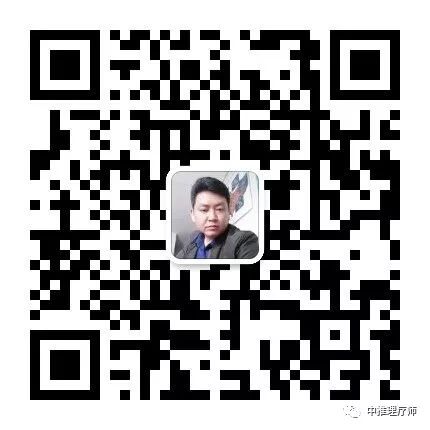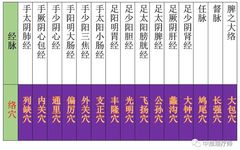
The Luo-connecting points are the acupoints where the Luo vessels branch out from the main meridians. Each of the fifteen Luo vessels has one acupoint, referred to as a Luo point (Luo-xue), also known as the “Fifteen Luo Points.” The term “Luo” implies connection and distribution. Each of the twelve main meridians has a corresponding Luo vessel, hence each has a Luo point. The Luo points of the twelve meridians are located below the elbow and knee joints of the limbs; the Luo point of the Ren meridian, Jiuwei, is located in the upper abdomen; the Luo point of the Du meridian, Changqiang, is located at the tailbone; and the Luo point of the Spleen’s major Luo, Daba, is located in the chest and lateral thorax.
Among the Luo points of the twelve meridians, they serve to connect the exterior and interior meridians and treat both exterior and interior diseases, or conditions affecting both the exterior and interior meridians. The Luo points of the Ren, Du, and the Spleen’s major Luo also facilitate the regulation of Qi and blood in the anterior, posterior, and lateral aspects of the trunk, and treat diseases of the chest, abdomen, back, waist, and lateral ribs.
The therapeutic effects of the Luo points mainly include the following aspects.
1) Each Luo point treats the conditions of its corresponding Luo vessel, whether it is deficient or excessive. For example, the Luo point of the Hand Shaoyin Heart channel, Tongli, when excessive, may present with fullness in the chest, and when deficient, may lead to inability to speak; both can be treated by needling the Luo point.
2) Luo points can connect the exterior and interior meridians, hence the saying “one Luo connects two meridians”; they can treat not only diseases of the primary meridian but also conditions of the corresponding exterior and interior meridians. For instance, the Luo point of the Hand Taiyin Lung channel, Lieque, can treat cough and wheezing of the Lung channel, as well as toothache and neck pain related to the Hand Yangming Large Intestine channel.
3) In cases of acute inflammation, needling the Luo points to induce bleeding can also yield good results.
4) In clinical applications, Luo points can be used alone or in combination with their corresponding primary points, known as the original Luo point pairing method.
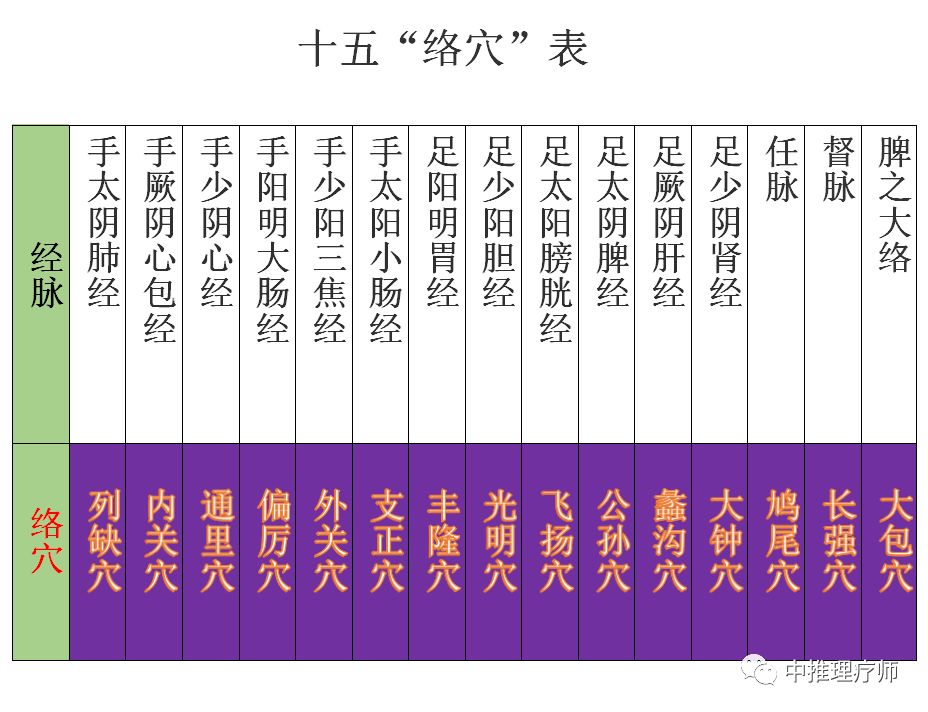
Fifteen Luo Points: Hand Taiyin Luo point Lieque; Hand Shaoyin Luo point Tongli; Hand Jueyin Luo point Neiguan; Hand Taiyang Luo point Zhizheng; Hand Yangming Luo point Pianli; Hand Shaoyang Luo point Waiguan; Foot Taiyang Luo point Feiyang; Foot Shaoyang Luo point Guangming; Foot Yangming Luo point Fenglong; Foot Taiyin Luo point Gongsun; Foot Shaoyin Luo point Dazhong; Foot Jueyin Luo point Ligou; Ren meridian Luo point Jiuwei; Du meridian Luo point Changqiang; Spleen’s major Luo point Daba. The twelve meridian Luo points are all located below the elbow and knee joints of the limbs, with Jiuwei, Changqiang, and Daba being distinct points where the twelve meridians diverge from the Ren, Du meridians, and the Spleen’s major Luo, hence “one Luo connects two meridians.”
Detailed Explanation of the Fifteen Luo Points
1. Hand Taiyin – Lieque Point
The main Luo vessel of the Hand Taiyin meridian branches out at the point called Lieque. This Luo vessel starts between the flesh at the wrist and runs parallel to the Hand Taiyin main meridian, entering the palm and dispersing at the edge of the thenar. If a pathological change occurs, the excessive condition may present with heat in the wrist and palm; the deficient condition may present with yawning and frequent urination. When treating, the Lieque point can be needled. The point is located 1.5 inches above the wrist. This Luo vessel also connects with the Hand Yangming meridian.
[Lieque Point]
Standard location: Lieque point is located on the radial side of the forearm, 1.5 inches above the wrist crease, between the tendons of the brachioradialis and the abductor pollicis longus. It is one of the important acupoints on the Hand Taiyin Lung meridian.
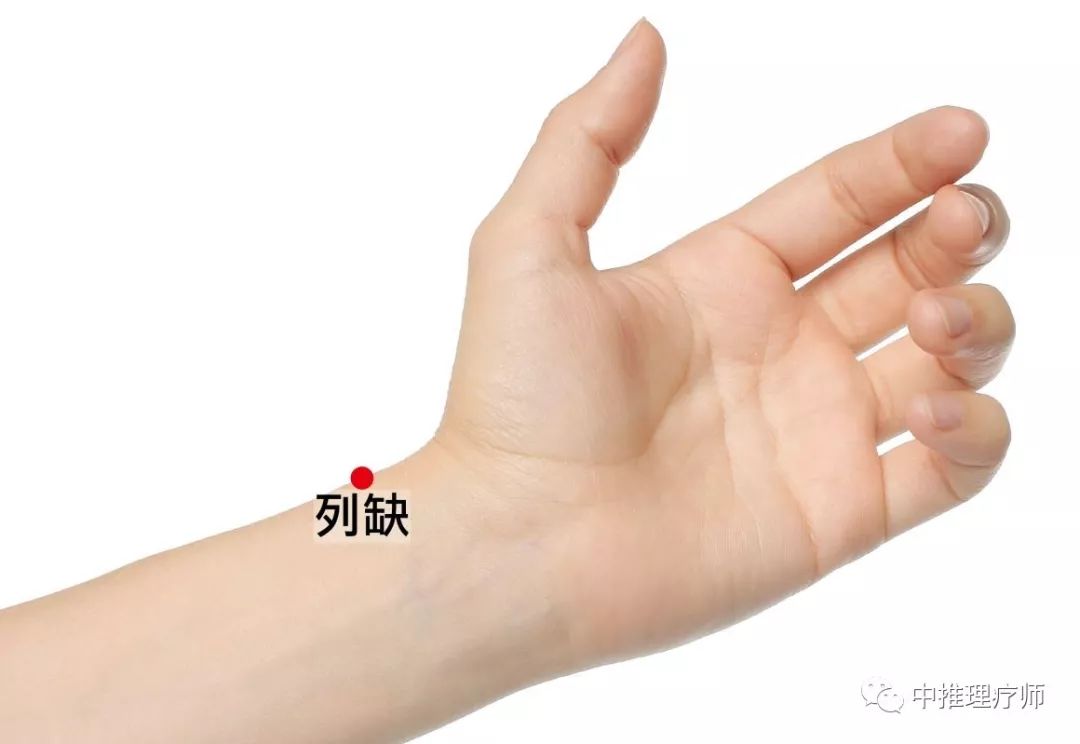
Lieque is the acupoint name (Lièquē LU7). It appears in the “Huangdi Neijing Ling Shu – Meridians.” Code: LU7. It belongs to the Hand Taiyin Lung meridian. Lieque is the Luo point of the Hand Taiyin Lung meridian and one of the eight meeting points, connecting with the Ren meridian. “Lie” means to line up, and “que” means deficiency. This point is not in a straight line with other points of the Hand Taiyin Lung meridian. In ancient times, lightning and the cracks in the sky were referred to as Lieque, and since the Hand Taiyin diverges from this point to connect with the Hand Yangming, it is named Lieque.
Indications
Lieque point is indicated for colds, exterior pathogens, fever and chills, cough, wheezing, shortness of breath, bronchial asthma, heat disease with agitation, sore throat, stiff neck, weakness in the wrist, heat in the palm, hematuria, numbness in the fingers, hemiplegia, facial droop, migraine, neck stiffness, toothache, neuralgic headache, facial nerve paralysis, urticaria, hematuria, dysuria, heat in urination, malaria, wind rash, low back pain, swelling of the limbs, breast abscess, and penile pain.
Point Pairing
Pair with Hegu point to treat wind-cold headache and neck stiffness.
Pair with Feishu point to treat cough and wheezing.
Pair with Hegu to treat exterior pathogens.
Pair with Houxi to treat neck pain.
Pair with Yangxi to treat wrist joint pain.
Pair with Hegu and Houxi to treat neck pain.
Pair with Taiyuan, Shizhu, and Zusanli to treat pulmonary tuberculosis.
Pair with Jingqu and Taiyuan to treat heat in the palm.
Pair with Houxi, Shaoze, and Qiangu to treat malaria.
Pair with Fengchi, Fengmen, and Hegu to disperse wind, release the exterior, and stop cough, indicated for colds, cough, and headache.
Pair with Zhaohai to descend Qi, relieve wheezing, and benefit the throat, indicated for cough, wheezing, and sore throat.
Needling and Moxibustion Techniques
Treatment method: If the Ren meridian is obstructed, needle inward with multiple thrusts and rotations; if the exterior and interior are obstructed, needle horizontally outward; if the main meridian is blocked, follow the meridian to unblock. If cold, tonify; if heat, drain; no moxibustion is applied, and moxibustion is ineffective.
Needling Technique
Needle obliquely upward 0.3-0.5 inches, with local soreness, heaviness, or radiating to the elbow or shoulder.
Note: The needling technique should not be too strong to avoid injuring the periosteum, causing severe pain and weakness in the wrist.
Moxibustion Technique
Moxibustion with 3-5 cones; or moxibustion with a stick for 5-10 minutes.
2. Hand Shaoyin – Tongli Point
The main Luo vessel of the Hand Shaoyin meridian branches out at the point called Tongli. It diverges 1.5 inches above the wrist, following the Hand Shaoyin main meridian upward, entering the heart, and then ascending to connect with the root of the tongue, belonging to the eye system. If a pathological change occurs, the excessive symptom is discomfort in the diaphragm; the deficient symptom is inability to speak. When treating, the Tongli point can be needled. The point is located 1 inch behind the palm (on the side of the little finger, on the palm surface). This Luo vessel also connects with the Hand Taiyang meridian.
[Tongli Point]
Standard location: Tongli is located on the palm side of the forearm, at the radial edge of the flexor carpi ulnaris tendon, 1 inch above the wrist crease.

Tongli is the acupoint name (Tōnglǐ HT5). It appears in the “Huangdi Neijing Ling Shu – Meridians.” In the “Beiji Qianjin Yaofang,” it is referred to as Tongli. It belongs to the Hand Shaoyin Heart meridian. Tongli is the Luo point of the Hand Shaoyin Heart meridian. “Tong” means to connect, and “li” refers to the neighborhood; the Luo vessel of the Hand Shaoyin Heart diverges from this point to connect with the neighboring Hand Taiyang meridian, hence the name Tongli.
Indications
Tongli point is indicated for sudden loss of voice, stiff tongue, acute paralysis of the stylohyoid muscle, sore throat, tonsillitis, cough, asthma, sudden loss of voice, palpitations, anxiety, wrist and arm pain, heat disease, headache with dizziness, eye pain, angina, bradycardia, arrhythmia, neurasthenia, mania, schizophrenia, hysteria, hysterical aphasia, fear of people, arm, elbow, wrist pain, pain in the inner posterior side of the forearm, finger spasms, heart pain, dizziness, vertigo, wrist joint pain, insomnia, facial redness, throat obstruction, fatigue, and excessive sleep, metrorrhagia, enuresis, gastric bleeding, endometritis, etc.
Point Pairing
Pair with Lianquan and Yamen to treat loss of voice.
Pair with Lianquan and Yamen to treat stiff tongue and sudden loss of voice.
Pair with Jinjun and Yuye to treat stiff tongue and sudden loss of voice.
Pair with Tai Chong, Yin Bai, and San Yin Jiao to treat excessive menstruation.
Pair with Taiyang and Fengchi to clear the head and benefit the eyes, indicated for headache and dizziness.
Pair with Lianquan and Yongquan to clear the heart and open the orifices, indicated for stiff tongue and hysterical aphasia.
Pair with Jiexi to treat head wind and facial redness.
Pair with Xingjian and San Yin Jiao to treat excessive menstruation.
Pair with Wangu to treat original Luo point pairing, calming the mind and stabilizing the spirit, indicated for mania and schizophrenia.
Pair with Wangu to treat swelling of the cheek and jaw.
Pair with Dazhong to treat fatigue and excessive sleep.
Needling and Moxibustion Techniques
Treatment method: If cold, connect; if hot, drain.
Needling Technique
Generally, needle straight 0.3-0.5 inches. Local soreness can be felt, and the sensation can also follow the heart meridian down to the ring finger or little finger, or follow the heart meridian up to the forearm, elbow pit, and in some cases, can reach the chest.
Moxibustion Technique
Moxibustion with 1-3 cones, or warm needle moxibustion for 10-20 minutes.
3. Hand Jueyin – Neiguan Point
The main Luo vessel of the Hand Jueyin meridian branches out at the point called Neiguan. It diverges 2 inches above the wrist, between the two tendons, following the Hand Jueyin main meridian upward, connecting with the pericardium. If a pathological change occurs, the excessive symptom is heart pain; the deficient symptom is stiff neck. When treating, the Neiguan point can be needled. The point is located between the two tendons 2 inches above the wrist.
[Neiguan Point]
Standard location: Neiguan is located on the palm side of the forearm, on the line connecting Quze and Daling, 2 inches above the wrist crease, between the tendons of the palmaris longus and the radial flexor of the wrist. It is one of the important acupoints on the Hand Jueyin Pericardium meridian.
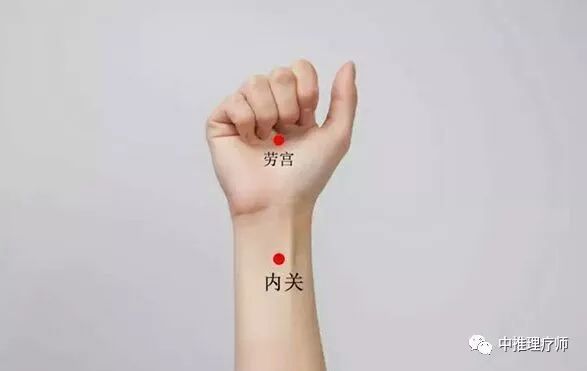
Neiguan is the acupoint name (Nèiguān PC6). It appears in the “Huangdi Neijing Ling Shu – Meridians.” It belongs to the Hand Jueyin Pericardium meridian. Neiguan is the Luo point of the Hand Jueyin Pericardium meridian, one of the eight meeting points, connecting with the Yinwei meridian. “Nei” means inner, and “guan” means pass; this point is located on the inner side of the forearm, resembling a pass, hence the name Neiguan.
Indications
Neiguan point is mainly used for cardiovascular, mental, and digestive system diseases: such as heart pain, palpitations, rheumatic heart disease, pericarditis, myocarditis, angina, arrhythmia, fainting, postpartum blood fainting, epilepsy, mania, insomnia, forgetfulness, fullness in the chest and ribs, intercostal neuralgia, stomach pain, gastroenteritis, gastric ulcer, neurogenic vomiting, diaphragm spasm, pregnancy sickness, and elbow and arm pain, hyperthyroidism, etc.
Point Pairing
Pair with Gongsun to treat abdominal pain.
Pair with Geqiu to treat fullness in the chest and ribs.
Pair with Zhongwan and Zusanli to treat stomach pain, vomiting, and hiccups.
Pair with Waiguan and Quchi to treat upper limb paralysis and hand tremors.
Pair with the affected side’s Xuanli to treat migraine.
Pair with Jianli to relieve chest tightness.
Pair with Jianshi and Zusanli to treat angina.
Pair with Yongquan and Zusanli to treat toxic shock.
Pair with Gongsun to treat stomach pain.
Pair with Taiyuan to benefit the heart and calm the mind, regulating Qi and pulse, indicated for absence of pulse.
Pair with Zusanli and Zhongwan to harmonize the stomach, descend counterflow, and regulate Qi to relieve pain, indicated for stomach pain.
Pair with San Yin Jiao and Hegu to benefit Qi, circulate blood, and resolve stasis to open the meridians, indicated for heart pain due to Qi deficiency.
Pair with Shenmen to calm the mind and spirit, indicated for insomnia.
Pair with Gongsun, as it is one of the eight meeting points, to harmonize the stomach and descend counterflow, indicated for hiccups.
Needling and Moxibustion Techniques
Treatment method: If cold, connect; if hot, drain.
Needling Technique
Generally, needle straight 0.3-0.5 inches. Local soreness can be felt, and the sensation can also follow the pericardium meridian down to the ring finger or little finger, or follow the pericardium meridian up to the forearm, elbow pit, and in some cases, can reach the chest.
Moxibustion Technique
Moxibustion with 1-3 cones, or warm needle moxibustion for 10-20 minutes.
4. Hand Taiyang – Zhizheng Point
The main Luo vessel of the Hand Taiyang meridian branches out at the point called Zhizheng. It diverges 5 inches above the wrist (on the side of the little finger, on the back of the hand), connecting with the Hand Shaoyin meridian, then ascends to the elbow, and further connects with the shoulder. If a pathological change occurs, the excessive symptom is joint looseness, and the deficient symptom is inability to move the elbow. Treatment can be done by needling the Zhizheng point.
[Zhizheng Point]
Standard location: Zhizheng point is located on the dorsal side of the forearm, on the ulnar side, on the line connecting Yanggu and Xiaohai, 5 inches above the wrist crease. It is the Luo point of the Hand Taiyang Small Intestine meridian.
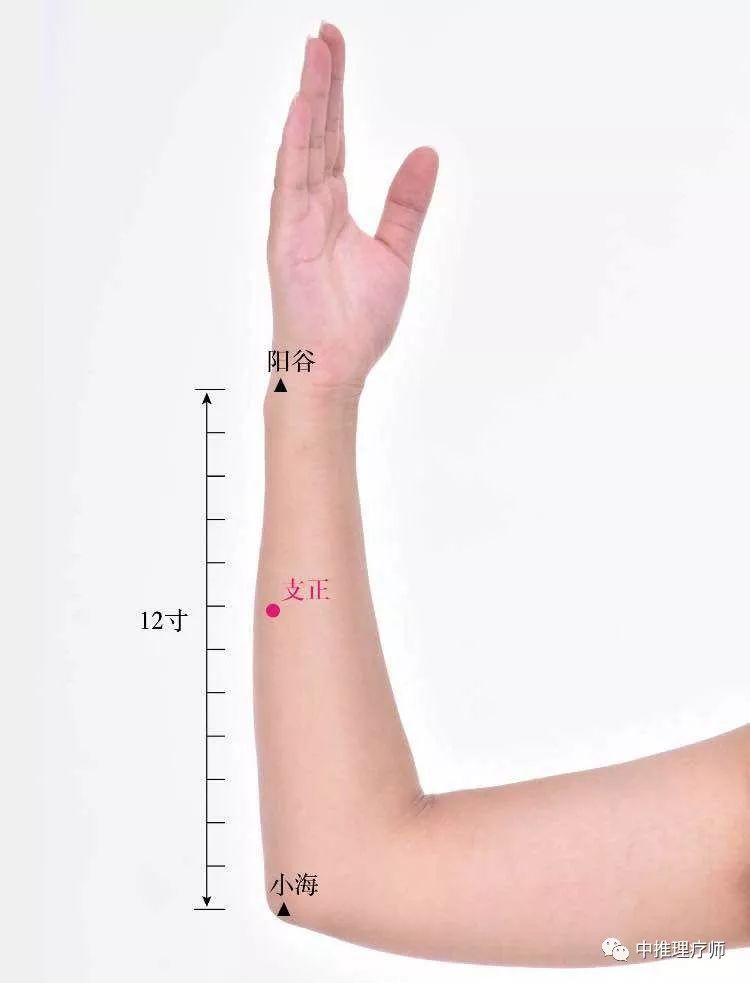
Zhizheng is the acupoint name (Zhīzhèng SI7). It appears in the “Huangdi Neijing Ling Shu – Meridians.” It belongs to the Hand Taiyang Small Intestine meridian. Zhizheng is the Luo point of the Hand Taiyang Small Intestine meridian. “Zhi” means to support, and “zheng” means to correct; the Hand Taiyang meridian diverges from this point to connect with the Hand Shaoyin meridian, hence the name Zhizheng.
Indications
Zhizheng point is indicated for stiff neck, elbow spasms, finger pain, headache, dizziness, neurogenic headache, heat disease, eye dizziness, excessive laughter, forgetfulness, easy fright, mania, mental illness, diabetes, cold and heat, swelling of the jaw, neurasthenia, epilepsy, mania, shoulder, arm, elbow spasms, inability to grip, ulnar nerve paralysis, swelling of the jaw, finger pain, hordeolum, weakness of the limbs, stiff neck, elbow spasms, scabies, duodenal ulcer, etc.
Point Pairing
Pair with Hegu to treat headache.
Pair with Sanjiao point to treat dizziness and headache.
Pair with Shenmen to treat mental illness. This is the original Luo point pairing method, which has a calming effect on the mind and spirit, indicated for mania and mental illness.
Pair with Quchi to treat elbow and finger pain, inability to grip.
Pair with Jianliao to relieve muscle and joint pain, indicated for shoulder, arm, and finger pain.
Pair with Yiji, Hegu, Shaohai, Quchi, and Wangu to treat mania.
Pair with Shaohai and Quchi to treat elbow and finger pain.
Needling and Moxibustion Techniques
Treatment method: If cold, tonify; if hot, drain.
Needling Technique
Needle straight or obliquely 0.5-0.8 inches, with local soreness, or radiating down to the hand.
Moxibustion Technique
Moxibustion with 3-5 cones, or warm needle moxibustion for 5-10 minutes.
5. Hand Yangming – Pianli Point
The main Luo vessel of the Hand Yangming meridian branches out at the point called Pianli. It diverges 3 inches above the wrist (on the side of the thumb, on the back of the hand), connecting with the Hand Taiyin meridian, and another branch enters the ear, connecting with the main vessel of that area. If a pathological change occurs, the excessive symptom is tooth decay and deafness; the deficient symptom is cold teeth and obstruction in the diaphragm. Treatment can be done by needling the Pianli point.
[Pianli Point]
Standard location: Pianli is located on the forearm, 3 inches above the wrist crease on the dorsal side, on the line connecting Yangxi and Quchi. The point can be located by crossing the thumbs, where the tip of the middle finger is the point.
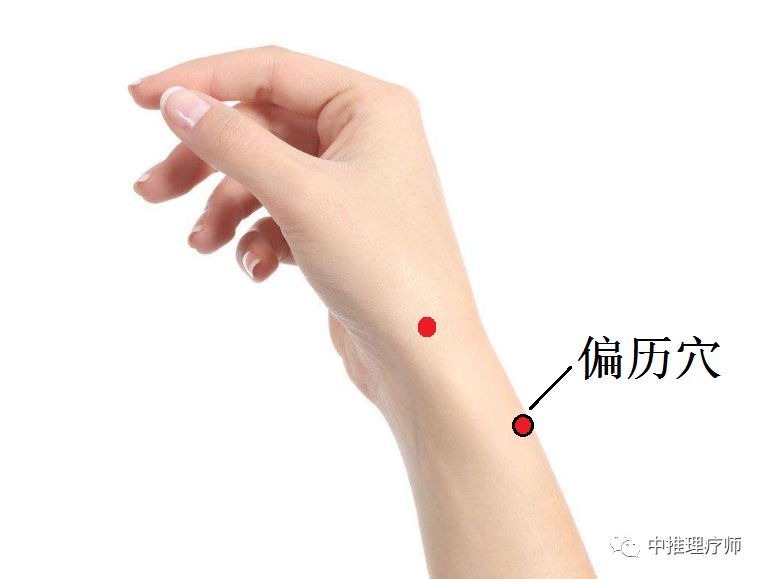
Pianli is the acupoint name (Piānlì LI6). It appears in the “Huangdi Neijing Ling Shu – Meridians.” It belongs to the Hand Yangming Large Intestine meridian. Pianli is the Luo point of the Hand Yangming Large Intestine meridian. “Pian” means to deviate, and “li” means to walk; the Hand Yangming meridian deviates from this point to connect with the Hand Taiyin meridian, hence the name Pianli.
Indications
Pianli point is indicated for tinnitus, deafness, red eyes, epistaxis, sore throat, tonsillitis, arm pain, swelling of the cheeks, red eyes, facial droop, tooth pain, water retention, dysuria, edema, shoulder pain, arm pain, elbow pain, wrist pain, facial nerve paralysis, tonsillitis, forearm neuralgia, epilepsy, etc.
Point Pairing
Pair with Quchi to treat arm pain.
Pair with Yifeng and Tinghui to treat tinnitus and deafness.
Pair with Tianshu, Zusanli, and Yinlingquan to treat abdominal distension and edema.
Pair with Shousanli to treat elbow and arm pain, difficulty in flexion and extension.
Pair with Hegu, Erjian, Kunlun, and Zhutong to treat epistaxis.
Pair with Yangxi, Shangyang, Luoque, Wangu, and Qiangu to treat tinnitus.
Pair with Guanyuan, Zhongji, and San Yin Jiao to treat edema.
Pair with Hegu, Quchi, and Zhizheng to treat shoulder and arm pain.
Pair with Taiyuan to benefit the heart and calm the mind, regulating Qi and pulse, indicated for absence of pulse.
Pair with Yinlingquan and Shanquan to promote diuresis, indicated for edema.
Pair with Yangxi, Shangyang, Luoque, Wangu, and Qiangu to clear heat and promote Qi flow, indicated for excessive pathogenic factors causing tinnitus.
Needling and Moxibustion Techniques
Treatment method: If cold, tonify; if hot, drain.
Needling Technique
Generally, needle straight or obliquely 0.5-1.0 inches.
Needle straight 0.3-0.5 inches, or needle obliquely towards the elbow, 0.5-0.8 inches, with local soreness.
Moxibustion Technique
Moxibustion with 3-5 cones, or warm needle moxibustion for 5-10 minutes.
6. Hand Shaoyang – Waiguan Point
The main Luo vessel of the Hand Shaoyang meridian branches out at the point called Waiguan. It diverges 2 inches above the wrist (on the dorsal midline), wrapping around the arm, then ascends to the chest, connecting with the Hand Jueyin pericardium. If a pathological change occurs, the excessive symptom is elbow joint stiffness; the deficient symptom is relaxation and inability to contract. Treatment can be done by needling the Waiguan point.
[Waiguan Point]
Standard location: Waiguan is located on the dorsal side of the forearm, on the line connecting Yangchi and the elbow tip, 2 inches above the wrist crease, between the ulna and radius. It is one of the important acupoints on the Hand Shaoyang Sanjiao meridian.
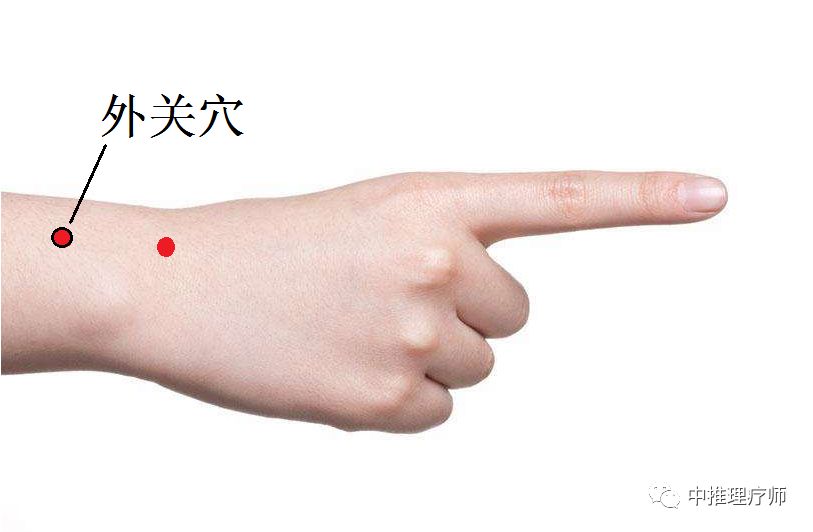
Waiguan is the acupoint name (Wàiguān TE5). It appears in the “Huangdi Neijing Ling Shu – Meridians.” It belongs to the Hand Shaoyang Sanjiao meridian. Waiguan is the Luo point of the Hand Shaoyang Sanjiao meridian, one of the eight meeting points, connecting with the Yangwei meridian. “Wai” means outer, and “guan” means pass; this point is located on the outer side of the forearm, resembling a pass, hence the name Waiguan.
Indications
Waiguan point is indicated for colds, headache, fever, tinnitus, deafness, eye pain, throat swelling, facial droop, chest and rib pain, hand tremors, and difficulty in flexing and extending the elbow.
In modern practice, Waiguan point is also used to treat colds, trigeminal neuralgia, mumps, hypertension, and sequelae of polio, hemiplegia, etc.
Point Pairing
Pair with Zhaohai to treat neck stiffness and shoulder pain.
Pair with Dazhui and Quchi to treat exterior heat diseases.
Pair with Yanglingquan to treat rib pain.
Pair with Dazhui, Quchi, and Fengchi to treat colds and fever.
Pair with Tinghui and Zhongzhu to treat deafness and tinnitus.
Pair with Quchi and Tai Chong to treat hypertension.
Pair with Jianliao, Quchi, Hand Sanli, and Hegu to treat upper limb paralysis.
Pair with Yangchi and Zhongzhu to promote circulation and relieve pain, indicated for finger pain and wrist joint pain.
Pair with Taiyang and Shuaigu to relieve wind and clear the meridians, indicated for migraine.
Pair with Houxi to relieve muscle and joint pain, indicated for stiff neck.
Pair with Zhaohai, as it is one of the eight meeting points, indicated for ear, eye, neck, and shoulder diseases.
Needling and Moxibustion Techniques
Treatment method: If cold, tonify; if hot, drain.
Needling Technique
Needle straight 0.5-1.0 inches, or penetrate Neiguan point, with local soreness, which may radiate to the fingers.
Moxibustion Technique
Moxibustion with 3-5 cones; or warm needle moxibustion for 5-10 minutes.
7. Foot Taiyang – Feiyang Point
The main Luo vessel of the Foot Taiyang meridian branches out at the point called Feiyang. It diverges 7 inches above the outer ankle, connecting with the Foot Shaoyin meridian. If a pathological change occurs, the excessive symptom is nasal congestion and runny nose, and the deficient symptom is nasal bleeding. Treatment can be done by needling the Feiyang point.
[Feiyang Point]
Standard location: Feiyang point is located on the posterior aspect of the lower leg, behind the outer ankle, 7 inches directly above Kunlun (BL60), 1 inch below the outer lower edge of the gastrocnemius muscle, at the transition point of the gastrocnemius and Achilles tendon, taken while sitting or lying on the side.

Feiyang is the acupoint name (Fēiyáng BL58). It appears in the “Huangdi Neijing Ling Shu – Meridians.” It belongs to the Foot Taiyang Bladder meridian. Feiyang is the Luo point of the Foot Taiyang Bladder meridian. “Fei” means to fly, and “yang” means to rise; this point is located on the outer side of the lower leg, where the meridian diverges to connect with the Foot Shaoyin meridian, hence the name Feiyang.
Indications
Feiyang point is indicated for diseases of the waist, legs, and ankles: such as headache, dizziness, epistaxis, stiff neck, low back pain, weakness in the knees, abdominal pain, foot weakness, gout, inability to flex or extend the toes, cold and fever, blood hemorrhoids, mania, etc.
In modern practice, Feiyang point is often used to treat rheumatoid arthritis, nephritis, cystitis, epilepsy, sciatica, and lower limb paralysis.
Point Pairing
Pair with Weizhong to treat leg pain.
Pair with Baihui and Houxi to awaken the mind and open the orifices; indicated for mania and epilepsy.
Pair with Taiwei for original Luo point pairing, which has the effect of clearing the head and nourishing Yin, indicated for headache, dizziness, and epistaxis.
Needling and Moxibustion Techniques
Treatment method: If cold, tonify; if hot, drain.
Needling Technique
Generally, needle straight 0.7-1 inch, with local soreness, and the sensation may radiate down the leg.
Moxibustion Technique
Moxibustion with 3-5 cones, or warm needle moxibustion for 5-10 minutes.
8. Foot Shaoyang – Guangming Point
The main Luo vessel of the Foot Shaoyang meridian branches out at the point called Guangming. It diverges 5 inches above the outer ankle, connecting with the Foot Jueyin meridian, and descends to the dorsum of the foot. If a pathological change occurs, the excessive symptom is coldness; the deficient symptom is weakness in the foot, inability to walk, and difficulty in standing. Treatment can be done by needling the Guangming point.
[Guangming Point]
Standard location: Guangming point is located on the anterior lateral side of the lower leg, 5 inches above the outer ankle tip, at the anterior edge of the fibula.
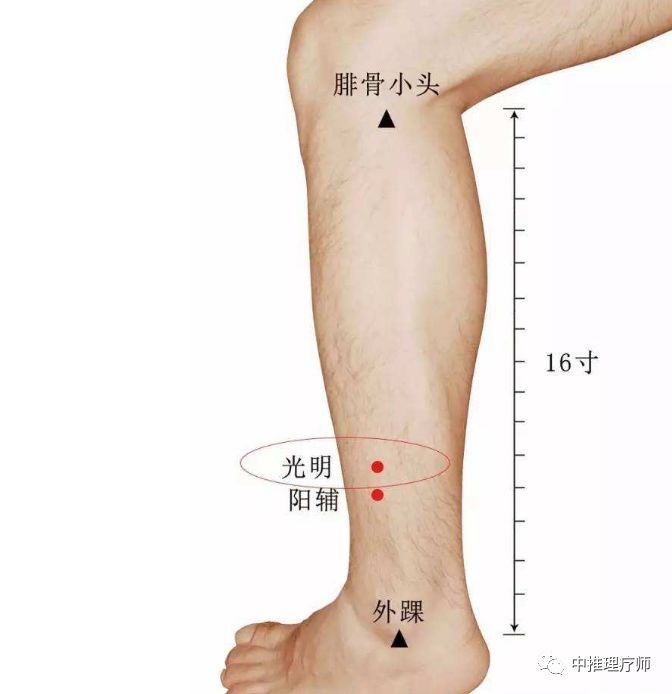
Guangming is the acupoint name (Guāngmíng GB37). It appears in the “Huangdi Neijing Ling Shu – Meridians.” It belongs to the Foot Shaoyang Gallbladder meridian. Guangming is the Luo point of the Foot Shaoyang Gallbladder meridian. “Guang” means bright, and “ming” means light; this point belongs to the Gallbladder meridian, which is good for treating eye diseases, hence the name Guangming.
Indications
Guangming point is indicated for pain in the lower leg, lower limb paralysis, migraine, eye pain, night blindness, myopia, epilepsy, breast pain; eye pain, itching, and leg and knee pain, coldness in the hands and feet, and pain in the lower abdomen.
In modern practice, Guangming point is often used to treat glaucoma, early cataracts, retinal atrophy, migraine, and calf muscle cramps.
Point Pairing
Pair with Gan Shu, Shen Shu, Fengchi, Mu Window, Jingming, and Xingjian to treat glaucoma and early cataracts.
Pair with Jingming, Chengqi, and Tongziliao to clear wind, clear heat, and drain fire, indicated for eye pain.
Pair with Yanglingquan and Kunlun to relieve muscle and joint pain, indicated for lower limb paralysis.
Needling and Moxibustion Techniques
Treatment method: If cold, tonify; if hot, drain.
Needling Technique
Needle straight 0.5-0.8 inches, with local soreness, which may radiate to the dorsum of the foot.
Moxibustion Technique
Moxibustion with 3-5 cones, or warm needle moxibustion for 5-10 minutes.
9. Foot Yangming – Fenglong Point
The main Luo vessel of the Foot Yangming meridian branches out at the point called Fenglong. It diverges 8 inches above the outer ankle, connecting with the Foot Taiyin meridian. Another branch ascends along the outer edge of the tibia to the head and neck, connecting with other meridians in that area, and descends to the throat. If a pathological change occurs, the excessive symptom is throat obstruction, sudden loss of voice; the deficient symptom is weakness in the foot, inability to contract, and atrophy of the tibial muscles. Treatment can be done by needling the Fenglong point.
[Fenglong Point]
Standard location: Fenglong is located on the anterior lateral side of the lower leg, 8 inches above the outer ankle tip, at the midpoint of the line connecting the Duni and the outer ankle tip; or 1 inch lateral to the Duni point.
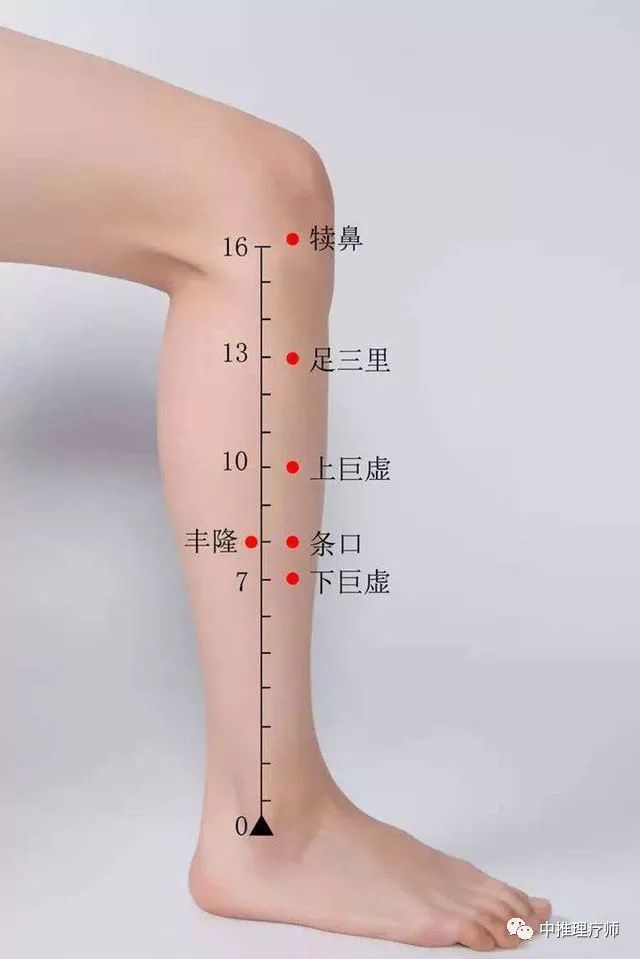
Fenglong is the acupoint name (Fēnglóng ST40). It appears in the “Huangdi Neijing Ling Shu – Meridians.” It belongs to the Foot Yangming Stomach meridian. Fenglong is the Luo point of the Foot Yangming Stomach meridian. “Feng” means rich, and “long” means to rise; the Foot Yangming meridian is abundant in Qi and blood, and this point is where it overflows into the major Luo, hence the name Fenglong.
Indications
Fenglong point is indicated for excessive phlegm, asthma, cough, bronchitis, chest pain, headache, dizziness, ear-related dizziness, sore throat, constipation, epilepsy, mania, edema, abdominal pain, cough with phlegm, weakness of the limbs, cold and fever, jaundice, and various other conditions.
In modern practice, Fenglong point is often used to treat phlegm-related conditions, schizophrenia, and various gastrointestinal disorders.
Point Pairing
Pair with Fengchi to treat dizziness.
Pair with Zhongwan and Feishu to treat excessive phlegm and cough.
Pair with Chongyang to clear phlegm and calm the mind, indicated for mania and excessive laughter.
Pair with Zhaohai and Taodao to clear phlegm and awaken the mind, indicated for epilepsy.
Pair with Yinlingquan, Shangqiu, and Zusanli to treat phlegm dampness.
Pair with Feishu and Shizhu to clear phlegm and stop cough, indicated for cough with excessive phlegm and asthma.
Pair with Quchi and Neiguan to treat hypertension.
Pair with Zhongwan and Neiguan to treat epilepsy.
Pair with Fengchi and Shenmen to treat insomnia.
Needling and Moxibustion Techniques
Treatment method: If cold, tonify; if hot, drain.
Needling Technique
Needle straight 1-1.5 inches, with the sensation radiating down the foot; needle straight 0.5-1.2 inches, with the sensation radiating down to the foot and ankle, and even to the second and third toes, used for lower limb weakness and swelling.
Moxibustion Technique
Moxibustion with 3-7 cones; or warm needle moxibustion for 10-20 minutes.
10. Foot Taiyin – Gongsun Point
The main Luo vessel of the Foot Taiyin meridian branches out at the point called Gongsun. It diverges 1 inch behind the first metatarsal (on the inner side) and connects with the Foot Yangming meridian. Another branch ascends into the abdomen, connecting with the intestines and stomach. If a pathological change occurs, the excessive symptom is sudden onset of cholera; the deficient symptom is abdominal distension. Treatment can be done by needling the Gongsun point.
[Gongsun Point]
Standard location: Gongsun is located on the inner side of the foot, at the base of the first metatarsal, at the junction of the red and white flesh.
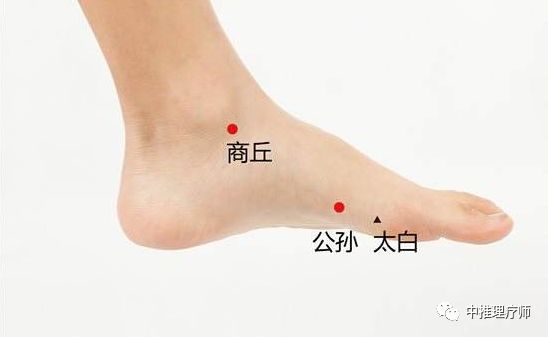
Gongsun is the acupoint name (Gōngsūn SP4). It appears in the “Huangdi Neijing Ling Shu – Ben Shu.” Code: SP4. It belongs to the Foot Taiyin Spleen meridian. Gongsun is the Luo point of the Foot Taiyin Spleen meridian; one of the eight meeting points, connecting with the Chong meridian. Gongsun is the surname of the Yellow Emperor, who ruled the world with the virtue of earth; this point belongs to the Spleen (earth) meridian, hence the name Gongsun.
Indications
Gongsun point is indicated for stomach pain, gastric spasm, epigastric pain, acute gastroenteritis, chronic gastroenteritis, gastric ulcer, indigestion, vomiting, hiccups, food stagnation, abdominal distension, diarrhea, insomnia, fatigue, mania, excessive sleep, edema, jaundice, dizziness, women’s blood fainting, retained placenta, epilepsy, malaria, flank pain, hernia, anal prolapse, neurogenic vomiting, pleurisy, intercostal neuralgia, intestinal bleeding, chest tightness, heart pain, insomnia, irritability, mania, dysmenorrhea, irregular menstruation, leukorrhea, foot pain, foot swelling, cholera, hepatitis, ascites, gastric cancer, endometritis, myocarditis, and heel pain.
Point Pairing
Pair with Zhongwan and Neiguan to treat excessive stomach acid and stomach pain.
Pair with Neiguan to treat stomach, heart, and chest diseases.
Pair with Jiexi, Zhongwan, and Zusanli to strengthen the spleen, transform food, and harmonize the stomach, indicated for food stagnation and epigastric pain.
Pair with Shugu and Bafeng to promote circulation and relieve pain, indicated for numbness and pain in the toes.
Pair with Zhongwan, Zusanli, and Neiguan to treat epigastric pain.
Pair with Fenglong and Danzhong to treat vomiting and dizziness.
Pair with Fenglong, Zhongkui, and Danzhong to strengthen the spleen and transform phlegm, indicated for vomiting phlegm and persistent dizziness.
Pair with Neiguan and Shenmen to treat chest pain.
Needling and Moxibustion Techniques
Treatment method: If cold, tonify; if hot, drain.
Needling Technique
Generally, needle straight, deep enough to penetrate the Yongquan point, with local soreness, which may radiate to the foot.
Moxibustion Technique
Moxibustion with 3-5 cones; or warm needle moxibustion for 5-10 minutes.
11. Foot Shaoyin – Dazhong Point
The main Luo vessel of the Foot Shaoyin meridian branches out at the point called Dazhong. It diverges behind the inner ankle, wrapping around the heel and reaching the outer ankle, connecting with the Foot Taiyang meridian. Another branch ascends along the Foot Shaoyin main meridian, running parallel to the pericardium meridian. If a pathological change occurs, the excessive symptom is agitation and fullness; the deficient symptom is low back pain. Treatment can be done by needling the Dazhong point.
[Dazhong Point]
Standard location: Dazhong is located on the inner side of the foot, behind the inner ankle, in the depression at the front of the attachment of the Achilles tendon.
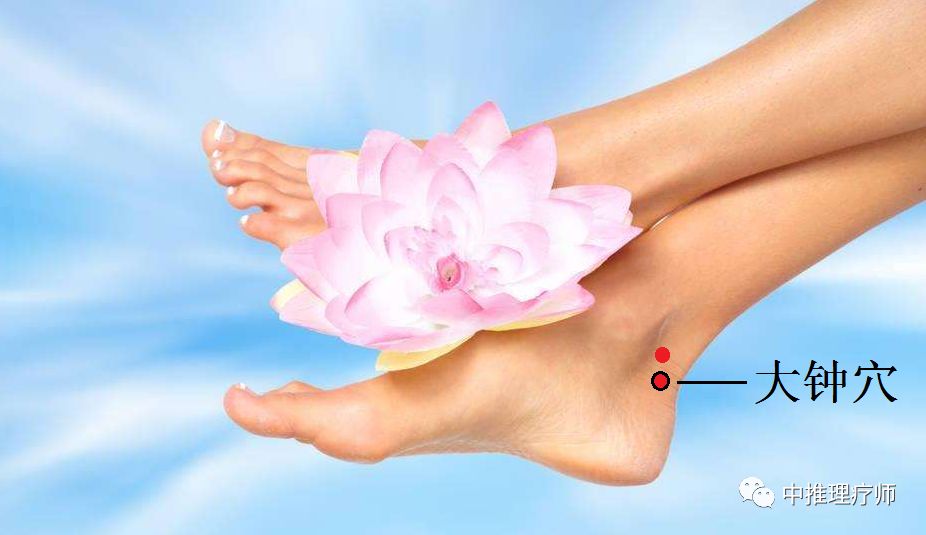
Dazhong is the acupoint name (Dàzhōng KI4). It appears in the “Huangdi Neijing Ling Shu – Meridians.” It belongs to the Foot Shaoyin Kidney meridian. Dazhong is the Luo point of the Foot Shaoyin Kidney meridian. “Da” means big, and “zhong” means heel; this point is located at the heel, which is larger, hence the name Dazhong.
Indications
Dazhong point is indicated for throat, chest, lung, heart, and diseases in the areas traversed by the meridian, such as sore throat, bleeding at the root of the tongue, food obstruction, cough with blood, asthma, agitation, excessive sleep, dementia, malaria, low back pain, frequent urination, heel pain, sore throat, asthma, hemoptysis, frequent urination, enuresis, constipation, low back pain, etc.
In modern practice, Dazhong point is often used to treat bronchial asthma, neurasthenia, hysteria, schizophrenia, oral inflammation, esophageal stricture, urinary retention, and mental illness.
Point Pairing
Pair with Zhongji and San Yin Jiao to clear heat and benefit the kidneys, indicated for urinary retention.
Pair with Shenmen and Taiyuan to nourish Yin and calm the mind, indicated for palpitations and insomnia.
Pair with Dingchuan, Shenyu, Feishu, Gaohuang, and Weiyang to treat kidney deficiency and asthma.
Pair with Shenyu, Guanyuan, San Yin Jiao to treat irregular menstruation.
Pair with Shenyu, Mingmen, Bladder Shu, Sanjiao Shu, and Weiyang to treat urinary difficulties.
Needling and Moxibustion Techniques
Treatment method: If cold, tonify; if hot, drain.
Needling Technique
Needle straight 0.3-0.5 inches, with local soreness.
Note: Do not needle deeply to avoid injuring the tibial nerve and posterior tibial artery, which may cause movement disorders in the foot.
Moxibustion Technique
Moxibustion with 3-5 cones; or warm needle moxibustion for 5-10 minutes.
12. Foot Jueyin – Ligou Point
The main Luo vessel of the Foot Jueyin meridian branches out at the point called Ligou. It diverges 5 inches above the inner ankle, connecting with the Foot Shaoyang meridian. Another branch ascends through the tibia to the testicular area, connecting with the penis. If a pathological change occurs, the excessive symptom is testicular swelling and sudden pain; the deficient symptom is itching of the scrotum. Treatment can be done by needling the Ligou point.
[Ligou Point]
Standard location: Ligou is located on the inner side of the lower leg, 5 inches above the inner ankle tip, at the center of the inner side of the tibia. It is the Luo point of the Foot Jueyin Liver meridian.
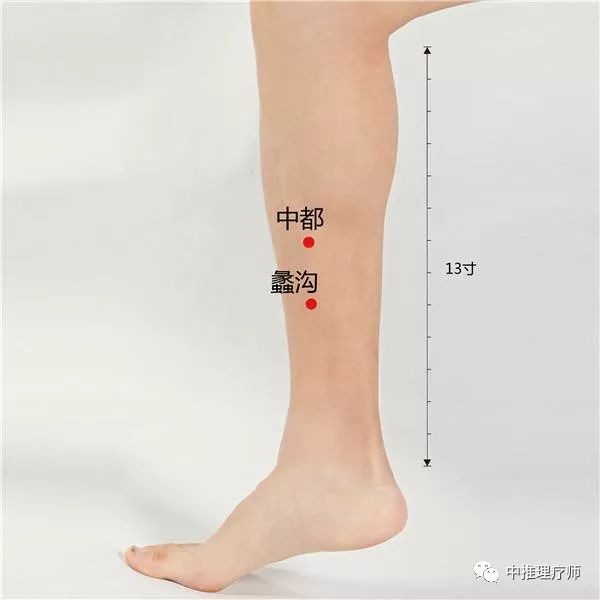
Ligou is the acupoint name (Lígōu LR5). It appears in the “Huangdi Neijing Ling Shu – Meridians.” It is also known as Jiaoyi. It belongs to the Foot Jueyin Liver meridian. Ligou is the Luo point of the Foot Jueyin Liver meridian. “Li” means shell, and “gou” means ditch; the shape of the gastrocnemius muscle resembles a shell, and the point is located in the inner ditch, hence the name Ligou.
Indications
Ligou point is indicated for liver and kidney, lower abdomen, and genital diseases: such as irregular menstruation, leukorrhea, testicular swelling, metrorrhagia, enuresis, urinary retention, genital pain and itching, impotence, hiccups, abdominal pain, low back pain, and coldness in the legs.
In modern practice, Ligou point is often used to treat endometritis, intestinal hernia pain, orchitis, and hypersexuality.
Point Pairing
Pair with Baichongwo, Yinlingquan, and San Yin Jiao to treat trichomonas vaginitis.
Pair with Zhongdu, Diji, Zhongji, and San Yin Jiao to treat irregular menstruation, leukorrhea, and orchitis.
Pair with Dadun and Qichong to treat testicular swelling, sudden pain, and leukorrhea.
Pair with Yinlingquan and San Yin Jiao to relieve pain in the tibia.
Pair with Tai Chong and Qihai to relieve liver Qi stagnation and pain, indicated for hernia and testicular swelling.
Pair with Baihui and Guanyuan for moxibustion or indirect moxibustion, to warm Yang and lift the sinking, indicated for uterine prolapse.
Needling and Moxibustion Techniques
Treatment method: If cold, tonify; if hot, drain.
Needling Technique
Needle horizontally 0.5-0.8 inches, with local soreness.
Needle obliquely along the posterior edge of the tibia 1.0-1.5 inches, with soreness radiating to the knee.
Moxibustion Technique
Moxibustion with 3-5 cones; or warm needle moxibustion for 5-10 minutes.
13. Ren Meridian – Jiuwei Point
The main Luo vessel of the Ren meridian branches out at the point called Jiuwei (also known as the Tail Feather point). It is located below the tip of the Jiuwei bone, dispersing in the abdomen. If a pathological change occurs, the excessive symptom is abdominal skin pain; the deficient symptom is itching of the abdominal skin. Treatment can be done by needling the Jiuwei point.
[Jiuwei Point]
Standard location: Jiuwei point is located in the upper abdomen, on the anterior midline, 1 inch below the xiphoid process. It is one of the main acupoints on the Ren meridian.
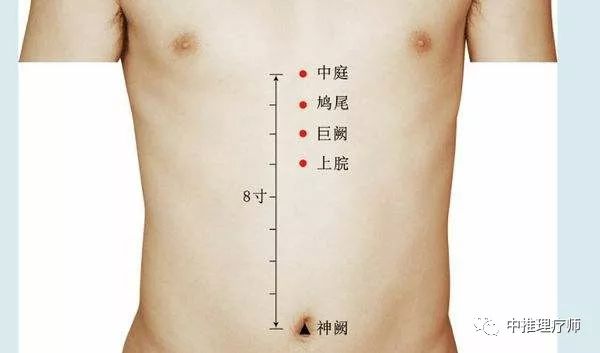
Jiuwei is the acupoint name (Jiūwěi CV15). It appears in the “Huangdi Neijing Ling Shu – Nine Needles and Twelve Origins.” It is also known as Tail Feather and Jian. It belongs to the Ren meridian. Jiuwei is the Luo point of the Ren meridian, the original point of the Ren meridian. “Jiu” means dove, and “wei” means tail; the xiphoid process resembles the tail of a dove, and this point is located below it, hence the name Jiuwei.
Indications
Jiuwei point is indicated for relieving fatigue, treating motion sickness, and alleviating irritability. It is mainly used for diseases of the chest, lungs, heart, and spleen and stomach, such as chest fullness, cough, epilepsy, stomach pain, vomiting, hematemesis, and inability to eat. In modern practice, it is often used to treat angina, bronchitis, asthma, pulmonary heart disease, mental illness, gastric spasm, and acute and chronic gastritis.
Point Pairing
Pair with Liangmen and Zusanli to treat stomach pain.
Pair with Sanjiao and Zusanli to treat vomiting.
Pair with Houxi to treat epilepsy.
Pair with Neiguan and Zhongwan to treat vomiting and hiccups.
Pair with Yongquan to transform phlegm and calm the heart, indicated for epilepsy and phlegm.
Pair with Zhongwan and Shaoshang to harmonize the stomach, clear heat, and relieve fullness, indicated for food stagnation and inability to sleep.
Needling and Moxibustion Techniques
Treatment method: If cold, tonify; if hot, drain.
Needling Technique
Needle straight 0.3-0.6 inches, needle downward obliquely.
Generally, hold the head with both hands, needle slightly downward obliquely 0.5-0.8 inches.
Moxibustion Technique
Moxibustion with 3-5 cones; or warm needle moxibustion for 5-10 minutes.
14. Du Meridian – Changqiang Point
The main Luo vessel of the Du meridian branches out at the point called Changqiang (located at the tip of the coccyx). It ascends along the spine, dispersing in the head, and then descends to the shoulders, diverging into the Foot Taiyang meridian, penetrating deeply into the spine. If a pathological change occurs, the excessive symptom is stiffness of the spine; the deficient symptom is heaviness and trembling of the head. If the symptoms arise from changes in the spine, treatment can be done by needling the Changqiang point.
[Changqiang Point]
Standard location: Changqiang point is located at the tip of the coccyx, at the midpoint of the line connecting the tip of the coccyx and the anus.
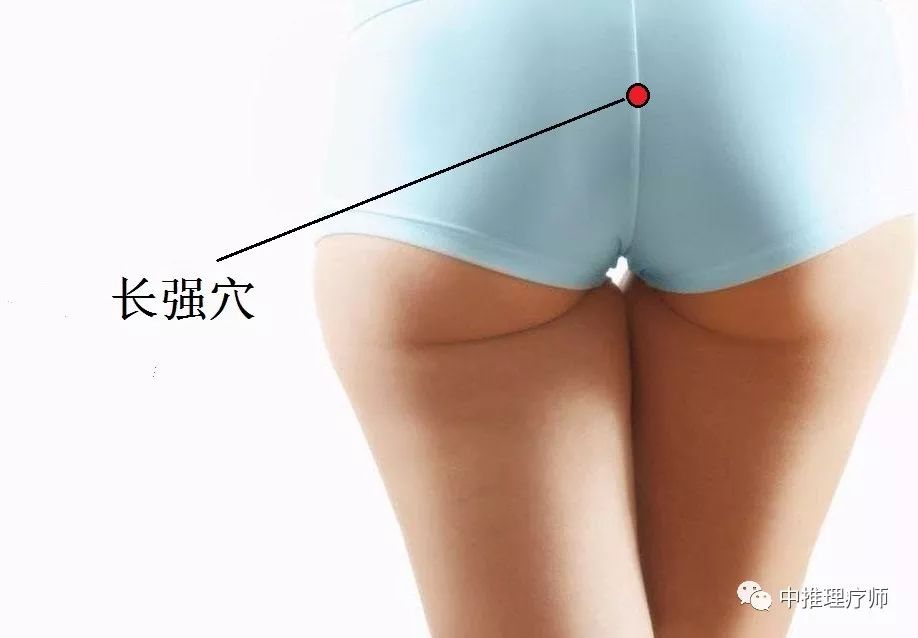
Changqiang is the acupoint name (Chángqiáng GV1). It appears in the “Huangdi Neijing Ling Shu – Meridians.” In the “Beiji Qianjin Yaofang,” it is referred to as Changjiang. It is also known as Qi’s Yinxi, Juegu, Qixi, and Guizhi. It belongs to the Du meridian. Changqiang is the Luo point of the Du meridian, connecting with the Shaoyin and Shaoyang meridians. “Chang” means long, and “qiang” means strong; the spine is long and strong, and this point is located below it, hence the name Changqiang.
Indications
Changqiang point is indicated for hemorrhoids, anal prolapse, blood in the stool, constipation, nocturnal emissions, enuresis, diarrhea, dysentery, low back pain, epilepsy, schizophrenia, vulvar itching, scrotal eczema, prostatitis, and pain in the lower back and coccyx.
Point Pairing
Pair with Erbai, Yinlingquan, Shangjuxu, and San Yin Jiao to treat hemorrhoids (with damp-heat type);
Pair with Jingguan, Erbai, and Baihui (moxibustion) to treat anal prolapse and hemorrhoids.
Pair with Chengshan for moxibustion to treat hemorrhoids, with the effect of clearing heat, promoting bowel movements, and invigorating blood, indicated for hemorrhoids and constipation.
Pair with Baihui and Qihai to treat anal prolapse.
Pair with Baihui to regulate the Du meridian, tonify Qi, and lift the sinking, indicated for anal prolapse and dizziness.
Pair with Yaoqi to treat epilepsy.
Pair with Xiaojing to promote Qi and clear the turbid, indicated for difficulty in urination and dysuria.
Pair with Shenzhu to promote Qi and clear the Du meridian, indicated for back pain.
Needling and Moxibustion Techniques
Treatment method: If cold, tonify; if hot, drain.
Needling Technique
Needle obliquely, with the needle tip parallel to the sacrum, inserting 0.5-1 inch. Do not penetrate the rectum to prevent infection; do not moxibust.
Needle obliquely 0.5-1 inch, close to the tip of the coccyx.
Moxibustion Technique
Moxibustion with 3-7 cones; or warm needle moxibustion for 5-15 minutes.
15. Spleen’s Major Luo – Daba Point
The major Luo of the spleen has an acupoint called Daba, located 3 inches below the armpit. This major Luo is distributed in the chest and lateral thorax. If a pathological change occurs, the excessive symptom is pain throughout the body; the deficient symptom is weakness and relaxation of the joints. Treatment can be done by needling the Daba point.
[Daba Point]
Standard location: Daba point is located on the lateral chest, on the midline of the armpit, at the sixth intercostal space. A simple method to locate the point is to lie on the side with the arm raised, taking the point 6 inches below the armpit, at the sixth intercostal space.
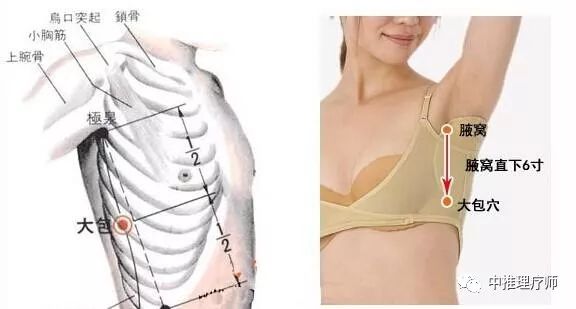
Daba is the acupoint name (Dàbāo SP21). It appears in the “Huangdi Neijing Ling Shu – Meridians.” It belongs to the Foot Taiyin Spleen meridian. Daba is the major Luo of the spleen. “Da” means big, and “ba” means to contain; this point belongs to the major Luo of the spleen, which is centrally located and has the broadest connection with all organs, hence the name Daba.
Indications
Daba point is indicated for fullness in the chest and ribs, cough, wheezing, asthma, rib pain, general body pain, weakness in the limbs, rib pain, pneumonia, pleurisy, intercostal neuralgia, chest fullness and pain, and myocarditis.
Point Pairing
Pair with Sanyangluo and Yangfu to treat rib pain;
Pair with Pishu and Zhangmen to treat excessive eating and thinness.
Pair with Waiguan, Shuigou, and Yanglingquan to treat joint pain.
Pair with Ganshu, Yanglingquan, and Zhigou to treat chest and rib pain.
Needling and Moxibustion Techniques
Needle obliquely or horizontally 0.3-0.5 inches. For neck sprains, needle obliquely upward, with local soreness. Moxibustion can be applied, with 3 cones of moxibustion, or moxibustion for 10-20 minutes.
Needling Technique
Needle obliquely or horizontally 0.5-0.8 inches, with local soreness.
For neck sprains, needle obliquely upward, with local soreness.
Note: The inner side is the lower part of the lung, deep needling is strictly prohibited.
Moxibustion Technique
Moxibustion with 3-5 cones; or warm needle moxibustion for 5-10 minutes.
Moxibustion with 3 cones, or moxibustion for 10-20 minutes.
Benefits of Massaging the Daba Point
1. Regulates asthma, wheezing, chest tightness, myocarditis, pleurisy, intercostal neuralgia, and other respiratory diseases; 2. Relieves general body pain, weakness in the limbs, and excessive eating; 3. Improves memory and relieves fatigue.
Follow our public account: ztys11118
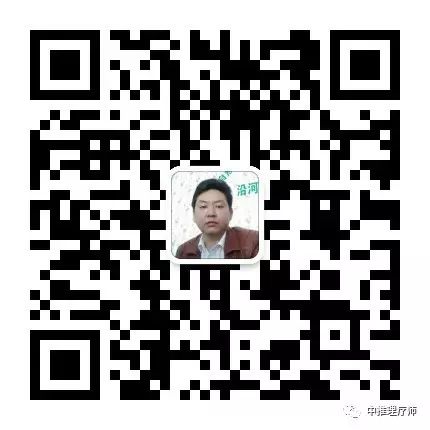
Follow our WeChat account: Ty11118
